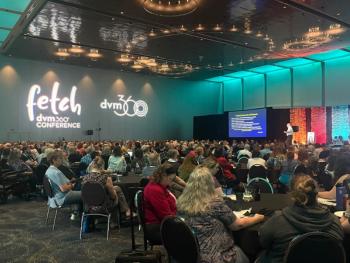
If a tree falls in the forest, does a veterinarian hear it?
Looking at a different industry can help us see the forest despite the trees.
In response to one of my previous columns, a veterinarian commented to me, “I consider the veterinarian production industry and the veterinary services industry analogous to the lumber and housing construction industries. They are intertwined and very much dependent on each other.” Here's a breakdown:
Industry
Raw material
Product
Veterinarian production Students Veterinarians Veterinary services Veterinarians Veterinary services Lumber Trees Lumber Housing construction Lumber Houses
“However,” this veterinarian continued, “unlike the lumber and construction industries, which help regulate each other's supply and demand, the veterinarian production industry seems to want to be independent of the veterinary services industry.”
Intrigued? Let's take a closer look.
Another vertically related market
There are three vertically related veterinary markets (veterinary services, veterinarians and veterinary education) and three vertically related housing markets (housing, lumber and timber). In the housing market, as housing inventory accumulates (the supply of houses exceeds demand), prices of new homes begin to fall, squeezing builder profits. Consequently, new housing declines.
This housing decline reduces the demand for lumber, causing the price of lumber to fall. As lumber prices fall, the millers' profits decline and the demand for timber (saw logs) is reduced. As a result, timber companies stop cutting trees. This whole process takes anywhere from six to 18 months. This quick adjustment time is the result of the close alignment of the housing, lumber and timber industries. Since there are only a few companies in each of these production areas, price signals are recognized and transmitted rapidly.
However, suppose the lumber company receives timber from 11,000 timber companies. And, more importantly, suppose the lumber company, rather than purchasing the saw logs from the timber company, just provided milling services. The timber companies would continue to own the saw logs after they were milled into lumber. As long as the supply of timber continued, the miller would continue to mill it and get paid for that service-even if housing prices started to fall and the price of lumber dropped. To reduce the supply of lumber, the timber companies would have to either reduce their supply of timber or go out of business.
This is a complicated situation, as each timber company is independent and some may continue to operate until they simply can no longer afford to do so. In industries with this type of structure, the adjustment may take years, since each timber company may be able to operate at a loss while covering variable costs for years before they are forced into bankruptcy.
Suppose the timber company owners had no knowledge of basic finance. As prices for lumber fell, the owners wouldn't realize that continued operation would eventually lead to bankruptcy. As debt increased, the owner would take out more loans, use more savings and so on. As a result, the adjustment period would take even longer.
Worse yet, some timber suppliers that were providing timber not used in housing would continue to flourish. Seeing their success without recognizing that they served a different market, and then averaging their price of lumber into all prices of lumber, would provide a distorted message to all timber companies.
What are the key differences?
The timber market and the veterinary education market differ in respect to their ownership of the supply of inputs. The veterinary colleges do not own the supply of students. Timber companies do, however, own the supply of timber. The timber is not walking out of the forest and demanding to be milled. Students do choose to apply (walk up) to veterinary schools. Unlike the timber company that can slow down production and continue to gain value in growing trees that can be reaped later, veterinary schools must fill their available seats or lose the revenue stream.
The rate at which a market adjusts to changing prices is a measure of market efficiency. Dead-weight loss occurs when the value of a final good or service is less than the cost of producing it. The more quickly the market adjusts, the less dead-weight loss occurs and the more efficient the market becomes.
The key is not to try to artificially control the market but to enhance the ability of the market to react to changing supply and demand. Supply and demand responds to changes in price. The better the price signal and the more the participants in the vertically related markets understand these signals, the more quickly they can adjust and the less waste occurs. In the timber market, smart companies watch the markets closely. As housing starts drop, smart companies reduce their harvest without waiting for the pricing signals from the millers.
The forest industry (milling and timber companies) has a cadre of applied economists working on the supply and demand components of the industry. Having consulted in this industry during the last three decades, I can assure you there is little about the markets that hasn't been examined and reexamined many times. As a result, there are many sources of information about prices that help guide the decisions of the firms involved in everything from planting trees to recycling used products.
This isn't the case for the veterinary profession. Not only is there very little market information, what does exist is disorganized and poorly analyzed, and there is contradictory information. A better understanding of the veterinary markets and better price information, provided in a timely manner, will improve the efficiency of the market for veterinary services. To get there won't be a sprint but a marathon.
Newsletter
From exam room tips to practice management insights, get trusted veterinary news delivered straight to your inbox—subscribe to dvm360.





